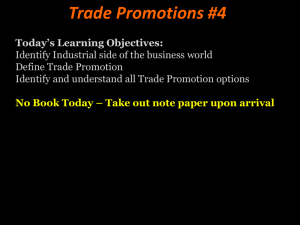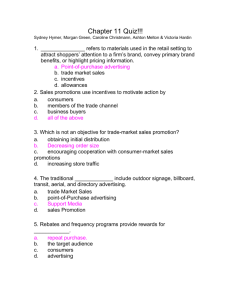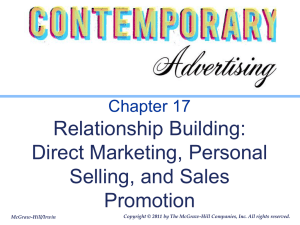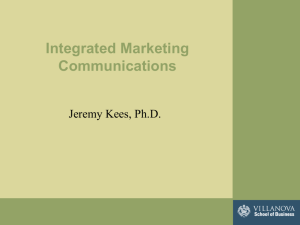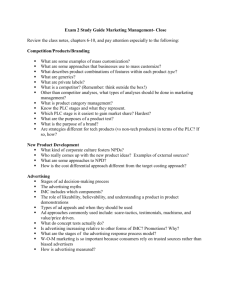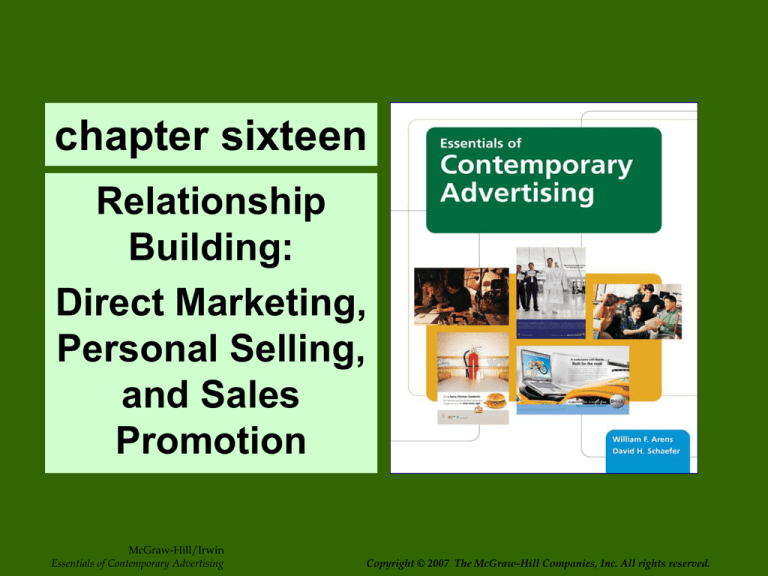
chapter sixteen
Relationship
Building:
Direct Marketing,
Personal Selling,
and Sales
Promotion
McGraw-Hill/Irwin
Essentials of Contemporary Advertising
Copyright © 2007 The McGraw-Hill Companies, Inc. All rights reserved.
Objectives_1
Discuss the importance of relationship
marketing and IMC
Define direct marketing and discuss its
role in IMC
Explain the importance of databases to
direct marketers
Discuss the role of personal selling in an
IMC program
16-2
Objectives_2
Describe the advantages and
drawbacks of personal selling
Define sales promotion and discuss its
importance as a communications tool
Identify the benefits and drawbacks of
sales promotion
Explain the difference between push
and pull strategies
16-3
Direct Marketing
Any direct communication to a
consumer or business recipient that is
designed to generate a response in the
form of an order, a request for further
information, and/or a visit to a store or
other place of business for the purchase
of a specific product(s) or services.
16-4
Largest Direct-Response Agencies
Draft Worldwide
Rapp Collins
Wunderman
Ogilvy One
McCann
Relationship
Marketing
Brann
Grey Direct
Targetbase
Marketing
Devon Direct
Protocol Marketing
Services
16-5
Database Marketing
The development and maintenance of a
data pool on current and prospective
customers used to target, segment, and
grade customers
16-6
Databases and Direct Marketing
Enables calculation of customer lifetime
value
Utilizes loyalty programs to build
customer relationships
Includes response to offers and offer
details as new data points in database
Enables use of RFM formula to identify
best customers
16-7
Exhibit 16-2 RFM Formula
The RFM formula is a model that provides marketers with
a method for determining the most valuable customers in
a database based on recency, frequency, and monetary
value. The larger a customer’s cumulative point score, the
more likely they are to make additional purchases.
16-8
Advantages of Direct Marketing
Development of a
good database
Relationship
approach to
marketing
Segmentation
Highly targeted
messages
Accountability
Measurability
Efficient
Unlikely to draw
competitive attention
16-9
Drawbacks to Direct Marketing
Bad reputation
No physical store
experience
Lack of prestige
associated with
medium
Cost per contact
Clutter
Privacy concerns
Lack of information
control for
consumers
16-10
Types of Direct Response Advertising
Direct
Mail
Interactive
Broadcast
Catalog
Sales
Print
16-11
Profile of Buyers from
Infomercials
Female
Middle aged
Caucasian
Employed full-time
Married with children
Suburbanite
$55,000 mean household income
16-12
Personal Selling
The interpersonal communication
process by which a seller ascertains
and then satisfies the needs of a buyer
to the mutual, long-term benefit of both
parties
16-13
Advantages of Personal Selling
Personal nature
Persuasion power
Ability to deal with
objections
Instant feedback
Tailored marketing
messages
Demonstration
ability
Relationship-based
Ability to ask for the
close
Effectiveness
16-14
Drawbacks of Personal Selling
Labor intensive
High cost per contact
Low reach
Few economies of scale
Poor reputation
Dependence upon salespeople
16-15
Functions of Salespeople
Information
Gathering
Information
Providing
Order
Fulfillment
Relationship
Building
16-16
Sales Promotion
A direct inducement that offers an
incentive anywhere along the marketing
route to enhance or accelerate the
product’s movement from producer to
consumer
16-17
Sales Promotion Elements
May be used anywhere in the marketing
channel (trade and consumer)
Involves a direct inducement for the
target to take some specific action
Designed to change the timing of a
purchase or to shift inventory another
channel member
Used as a value-added tool
16-18
Effective Sales Promotions
Set specific
objectives
Set a relevant
theme
Involve the trade
Coordinate with
campaign
Understand roles of
basic techniques
Use simple copy
Use contemporary
graphics
Clearly
communicate
concept
Pretest and
measure response
Reinforce brand
message and image
16-19
Sales Promotion Strategies
Push Strategy
Producer
Marketing
communications
Marketing
communications
Producer
Reseller
Marketing
communications
End
user
Pull Strategy
Request product Reseller
Request product
End
user
16-20
Types of Trade Sales Promotions
Slotting allowances
Trade deals
Display allowances
Buyback allowances
Ad allowances
Co-op advertising
Dealer premiums
Conventions/ meetings
16-21
Types of Consumer Sales
Promotions
POP materials
Coupons
Convenience cards
Cents-off promotions
Refunds/rebates
Premiums
Sampling
Combination offers
Contests/sweepstakes
16-22
Key Terms_1
Advertising
allowance
Buyback allowance
Catalog
Cents-off promotion
Combination offer
Company
convention
Consumer sales
promotion
Contest
Convenience card
Cooperative
advertising
Coupon
Customer lifetime
value
16-23
Key Terms_2
Database
Database marketing
Database
management
Database query
Dealer meeting
Direct marketing
Direct-response
advertising
Direct sales
Direct selling
Display allowance
Diverting
Electronic coupon
Forward buying
16-24
Key Terms_3
Freestanding inserts
Game
In-store sampling
Linkage media
Loyalty program
Personal selling
Point-of-purchase
materials
Polybagging
Premium
Pull strategies
Push money
Push strategies
Rebate
RFM formula
Sales promotion
16-25
Key Terms_4
Sampling
Slippage
Slotting allowance
Spiff
Sweepstakes
Telemarketing
Trade advertising
Trade concentration
Trade deal
Trade promotion
16-26


